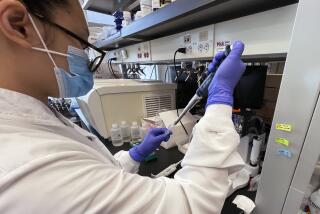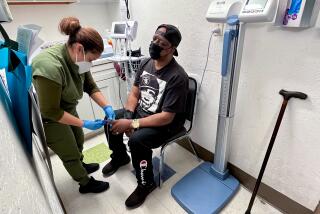Unsterile Devices Prompt Warnings
- Share via
SAN FRANCISCO — The California Department of Health Services has issued warnings to 1,000 hospitals and clinics statewide about the use of undisenfected probes in routine colon exams. The manufacturer of the devices, meanwhile, has alerted another 2,200 hospitals across the nation to take safeguards against similar contamination.
The warnings went out after two Sacramento-area hospitals last month advised 3,250 patients to take blood tests to ensure they had not contracted infectious diseases through exposure to an unsanitized chamber inside an instrument called a colonoscope.
Although none of the patients from Sutter Auburn Faith Hospital and Sonora Community Hospital have reported an illness so far, some patients in other parts of the country have contracted diseases such as hepatitis and the sexually transmitted human papilloma virus. Others suffered extreme anxiety when notified that they had been examined with dirty equipment and should return for follow-up blood tests.
Although officials acknowledge that improperly cleaned devices can transmit disease, the national governing organization of gastroenterologists says the threat of becoming infected by an endoscope is one in 1.8 million. Some health activists contend that the chances are much greater.
“Colonoscopes save thousands of lives every year,” said Jan Emerson, a spokeswoman for the California Health Care Assn. “As long as health care is provided by humans, there’s always the chance that unfortunate things are going to happen. But that absolutely should not mean that people should stop getting these critical tests.”
The flexible hose-like probes -- known as bronchoscopes, sigmoidoscopes and colonoscopes, depending on what part of the body they examine -- use a fiber-optic lens to allow doctors to peer inside the throat, lungs and other parts of the body without surgery. They are used 15 million times a year by various medical providers.
But despite the fact that thousands of patients nationwide have received warning letters about the prospect of being made sick by dirty probes, government agencies have done little to address the problem, critics allege.
The nation’s leading manufacturer of endoscopes has known for a decade that some scopes contain cavities inaccessible to cleaning by hand but has failed to fix the oversight, said David Lewis, a University of Georgia research microbiologist who has conducted research for the federal Environmental Protection Agency on the issue of dirty endoscopes.
Lawyers representing patients who have sued hospitals and clinics over the issue add that many clinicians ignore established cleaning guidelines and rush through the disinfecting process in a McDonald’s-style push to serve more clients.
“This is the health-care industry’s dirty little secret,” said attorney Jamie Sheller, who represents patients who sued a New Jersey clinic.
The Society of Gastroenterology Nurses and Associates said no one government agency is solely responsible for monitoring the use of the devices. Said President Paulette Smith: “It’s up to individual institutions to make sure the standards are being followed.”
And a spokeswoman for the U.S. Food and Drug Administration, which regulates the manufacture of endoscopes, said the agency has not issued any citations against endoscope makers in the last five years.
That’s not good enough for Lewis. “The industry’s solution has been to bury its head in the sand,” he said. “They just deny the problem exists.”
Patients, meanwhile, say that the stress alone of receiving a warning letter takes its toll. Returning for repeat precautionary blood tests to ensure that they did not contract a communicable disease affects everything from their jobs to relationships with friends and family.
“Can you imagine being worried about colon cancer, so you go through this procedure only to be told that you were fine but now you could have a virus from the scope that causes colorectal cancer?” asks Lewis.
Blood Tests Urged
Officials at the two California hospitals say their patients stand little chance of becoming ill. But as a precaution they advised patients -- one letter explained that it was for their “peace of mind” -- to return for the follow-up blood tests.
“This was obviously not something you enjoy doing,” Dr. John Barnsdale, chief of staff at the Sutter Auburn Faith Hospital, said of the recent round of warning letters. “But there was an error here. And people deserve to be told.”
Olympus America Inc., which manufactures the colonoscope that prompted the patient warning letters, also contacted 2,200 hospitals nationwide to remind them of proper cleaning procedures.
Olympus officials acknowledge that the company is aware of scope cleaning problems. They say that the issue has increasingly been factored into the design of the devices. “Our focus is patient health and safety,” said Laura Storms-Tyler, director of regulatory affairs and quality assurance. “We’re very sympathetic to patients who have to live through the worry of potentially becoming infected by an endoscope.”
Since 1999, there have been numerous health scares related to unclean endoscopes.
* Baltimore’s Johns Hopkins Hospital in March sent letters to 400 patients warning that they might have been exposed to pneumonia bacteria through bronchoscopes during throat exams. More than 100 of those tested positive for the bacteria.
* New York City health officials in 2001 contacted 2,000 patients who underwent gastrointestinal exams at a Brooklyn clinic after at least eight patients tested positive for hepatitis C, a liver disease caused by a blood-borne virus. Although officials suspect the reuse of contaminated needles, others say the clinic’s failure to sterilize biopsy forceps or properly clean the scopes was the more likely the cause of the outbreak. As a result, New York legislators are studying whether to toughen the state’s disinfectant standards for endoscopes.
* Olympus, the No. 1 maker of medical scopes, in 2002 conducted a worldwide recall of 14,000 bronchoscopes -- including 4,000 in the U.S. -- after reports that a part that came loose could trap bacteria inside.
Joseph Long, a 65-year-old New Jersey grandfather, said common sense persuaded him to undergo a colonoscopy in September 2000. A few weeks later, a woman from the endoscopy clinic called to inform him that a machine that disinfects the scopes had malfunctioned
“I was floored,” said the retired mechanical engineer.
For months, Long returned for blood tests. His daughter, meanwhile, was skittish over his touching his grandchildren. He surfed the Internet to investigate just what kinds of diseases he might be up against.
“All I could think of was that I was going to lose my husband,” says Barbara Long. “You get this procedure to live longer and this is what happens.”
Long never got sick. But another endoscopy patient from Los Angeles wasn’t so fortunate.
The man, who asked that his name not be used, says a colonoscopy in 1998 to treat mild hemorrhoids exposed him to the human papilloma virus, a sexually transmitted disease usually spread through anal sex.
“When I got sick, my wife said it must be the colonoscopy and I said ‘No way. That thing was clean.’ I’d never dream in a million years they would stick something inside of me that was reused and not sterile,” said the man, who is in his 40s. “It’s incredibly humiliating to have a disease when you’ve done nothing remotely near what it takes to subject yourself to this.”
There is wide consensus that it is difficult to sterilize the devices, which can cost $28,000 each, without using temperatures so high that the scopes themselves become damaged. The scopes have numerous cavities that are difficult to clean, even by hand, critics say.
Acknowledged Timothy Ulatowski, an FDA official who oversees endoscope compliance: “When these things were designed, cleaning and sterilization was obviously an afterthought.”
Even the government can’t agree on how long is needed to clean the devices. The FDA says endoscopes should be disinfected for 45 minutes to kill tuberculosis bacteria, but the Centers for Disease Control believes the job can be done in 20 minutes, Lewis says.
He and other microbiologists advocate sterile disposable parts for endoscopes as well as the use of a condom-like sheath for each new patient. But they say manufacturers and health-care providers have resisted such solutions because of added costs.
Lewis says Olympus, which provides 70% of endoscopes on the U.S.market, has long been aware of cleaning problems associated with its product. In a patent filed in 1993, he says, the company wrote that at times “satisfactory cleaning cannot be achieved.”
Although Lewis says the company still makes some endoscopes in which all internal channels cannot be disinfected, the company insists it is moving toward improvements.
Federal Guidelines
Heath-care activists say many overworked hospital and clinic workers will cut corners on cleaning to save time. A 1997 survey in the Archives of Family Medicine showed that most primary care physicians in the United States failed to follow more than one-third of the federal guidelines for the proper use of sigmoidoscopes, used to detect colon cancer.
California public health officials say inspectors may soon begin to consider endoscope cleaning procedures when they make accreditation visits every three years at hospitals and clinics.
“We expect to hear from other hospitals that they’ve had similar problems,” said Jon Rosenberg, a public health officer in the division of communicable disease control of the state Department of Health Services.
“Once five or 10 people inside a hospital become aware of a health problem,” Rosenberg said, “somebody eventually comes forward.”
More to Read
Sign up for Essential California
The most important California stories and recommendations in your inbox every morning.
You may occasionally receive promotional content from the Los Angeles Times.














